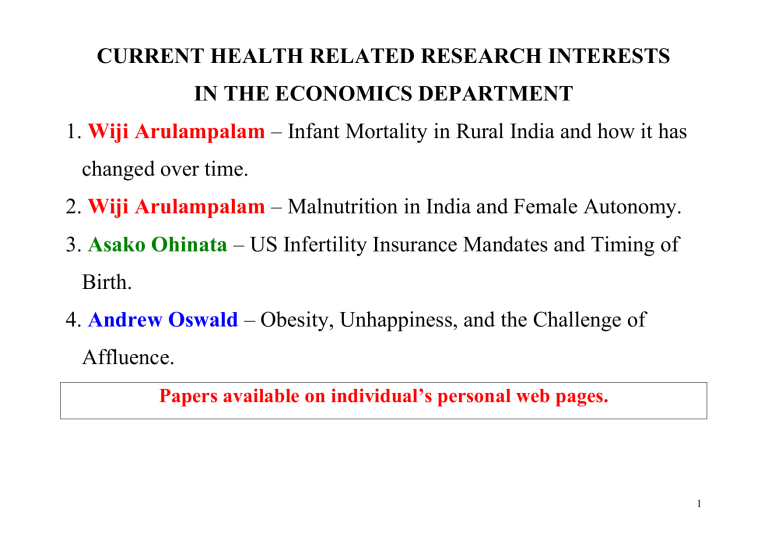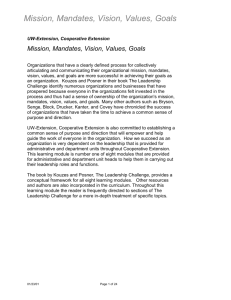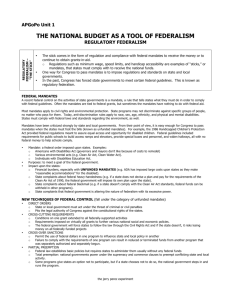CURRENT HEALTH RELATED RESEARCH INTERESTS IN THE ECONOMICS DEPARTMENT 1.

CURRENT HEALTH RELATED RESEARCH INTERESTS
IN THE ECONOMICS DEPARTMENT
1.
Wiji Arulampalam – Infant Mortality in Rural India and how it has changed over time.
2.
Wiji Arulampalam – Malnutrition in India and Female Autonomy.
3.
Asako Ohinata – US Infertility Insurance Mandates and Timing of
Birth.
4.
Andrew Oswald – Obesity, Unhappiness, and the Challenge of
Affluence.
Papers available on individual’s personal web pages.
1
Infant Mortality in Rural India and how it has changed over time
1.
First country to launch a family planning programme in the world. India provides funding for planned development for nationwide improvement of health status of mothers and their children.
Health education and promotion is an integral part of all national health and family welfare programmes.
2.
Around 7% of the children born in 2002 died before reaching their first birthday. That is 1.69
million infant deaths. Has signed up to the MDG: reduce IMR to 27 (deaths per 1000 live births) by 2015.
Data:
Indian National Family Health Survey (Part of the Demographic Health Surveys)
1992/93; 1998/99; 2005/06.
2
50
40
30
20
10
0
90
80
70
60
56
85
79
1992/93
Infant Mortality - India
47
73
68
1998/99
NFHS
42
62
57
2005/06
Urban
Rural
Total
Need to recognise: Inter state variations (2004: Kerala: 14; Orissa: 98)
• Intra state variations
• Urban vs Rural (Higher in Rural areas)
• Intra village variations
• Within families – CLUSTERING!
3
What Drives Clustering:
Heterogeneity between households.
[observed, unobserved] and/or
Scarring: causal process by which the death of a child predisposes the succeeding sibling to a higher death risk.
[‘Scarring’ (beneficial): There could be a positive learning effect for the family from the experience of a death.]
Death of a child
cessation of breastfeeding
mother able to conceive again
short birth interval to next child (<24 months)
higher death risk for this child.
Mitigated by the fact that death of the preceding sibling reduces resource competition and infection risks for the index child.
Policy Motivation:
• Contributes to our understanding of inter-relations of family behaviour, fertility & mortality.
• Excess vulnerability of households that have experienced a child death: targeting.
• If there is genuine scarring then policies that improve access to and take-up of contraception will reduce clustering and overall mortality rates.
4
Asako OHINATA : Did the US infertility insurance mandates affect the timing of birth?
Abstract
Several US states between 1977-1995 mandated health insurance providers to offer coverage for infertility treatment.
Although the majority of past literature studies impacts on older women who are likely to seek treatment, this paper proposes that the mandates may have had a wider impact on the US population. Specifically, it may have given an option for younger women to delay birth and thus advance in their careers first. Results estimated by the discrete-time proportional hazard model suggests a significant delay in the time to first birth among highly educated women as well as those working in medium sized firms.
Introduction
The number of people with impaired fecundity in the US increased by approximately 25 % between 1982 and
1995 (Chandra 1998).
13 states introduced state-level insurance mandate between 1977 and 2001 that mandated health insurance providers to give coverage for infertility treatment.
If the increase in the impaired fecundity in the recent years is due to postponement of birth in order for women to advance in their careers first, such mandates may induce women to further delay giving births , since the knowledge of easily accessible infertility treatments may lead women to focus on work for a longer period of their lives and postpone giving birth.
5
Aim
To determine if women aged between 20 and 25 in the US delayed their timing of birth in response to the introduction of state-level insurance mandates.
Method
In order to identify the impact of state insurance mandates, compare women living in mandated states vs. non-mandated states
Pr(first birth| no child ) in mandated states before the introduction of mandates
Pr(first birth| no child) in non-mandated states before the introduction of mandates
-
-
Pr(first birth| no child ) in non-mandated states after the introduction of mandates
Pr(first birth| no child ) in non-mandated states before the introduction of mandates
=
=
Difference in
Pr(first birth) in mandated states
|
Difference in
Pr(first birth) in non- mandated states
||
Impact of Mandates
Who are likely to be affected?
Reason
Women with higher education
Women who are working in middle sized firms
They are likely to have more attachment to the labor market and thus may delay their timing of birth in response to the availability of cheaper infertility treatment.
Most Americans receive health insurance through their employers. Large firms tends to offer health insurance by themselves (“self insurance”) . This type of insurance is not under the control of the state mandates. Small firms tends to suffer from not being able offer health insurance. Therefore, women working in middle sized firms are most likely to be affected.
6
Results
N.B Negative sign implies that the mandates delayed the timing of birth.
Estimates in column (1) presents insignificant and positive impact of mandates when all women aged between 20-25 are looked at.
Estimates in column (2) presents again, an insignificant impact of mandates on women even when looking at women residing in mandates that offered more generous coverage.
When effect on women with more than 13 years of education are looked at
(column (3)), we find a significantly negative impact of mandates.
Similarly, women working in middle sized firms significantly delayed birth more than those working in small or jumbo firm
7
Conclusions
No strong effect is observed when all women aged between 20-25 are studied. However, significant delay of birth is observed among women with high education and those working in middle sized firms .
If women delayed their birth until later….
1. The birth outcome may worsen
2. The success rates of treatments may go down.
3. Due to 1 and 2, the treatment cost may go up.
Future policy design must take account of the possible delaying effect and combine a mechanism which informs women of the risks associated with late pregnancies (e.g. age restrictions).
8
Andrew Oswald : Is affluence a good thing?
The book The Challenge of Affluence by Avner Offer (2006) argues that economic prosperity weakens self-control and undermines human well-being. Consistent with a pessimistic view, we show that psychological distress has been rising through time in modern Great Britain. Taking over-eating as an example, our data reveal that half the British population view themselves as overweight, and that happiness and mental health are worse among fatter people in both Britain and Germany. A 10-point move up in body mass index (BMI) is associated in the cross-section with a drop in psychological health of approximately 0.3 GHQ points. Comparisons also matter.
For a given level of BMI, we find that people who are educated or who have high income are more likely to view themselves as overweight. We discuss problems of inference and argue that longitudinal data on BMI are needed. We suggest a theory of imitation -- where utility depends on relative weight -- in which there can be obesity spirals after only small drops in the price of food.
Published in Social Science and Medicine 2008
9
Andrew Oswald: Psychological well-being
We present evidence that psychological well-being is U-shaped through life. A difficulty with research on this issue is that there are likely to be omitted cohort effects (earlier generations may have been born in, say, particularly good or bad times). First, using data on
500,000 randomly sampled Americans and West Europeans, the paper designs a test that can control for cohort effects.
Holding other factors constant, we show that a typical individual’s happiness reaches its minimum -- on both sides of the Atlantic and for both males and females -- in middle age. Second, evidence is provided for the existence of a similar U-shape through the life-course in East European, Latin American and Asian nations. Third, a U-shape in age is found in separate well-being regression equations in 72 developed and developing nations. Fourth, using measures that are closer to psychiatric scores, we document a comparable well-being curve across the life cycle in two other data sets: (i) in GHQ-N6 mental health levels among a sample of 16,000 Europeans, and (ii) in
10
reported depression and anxiety levels among 1 million U.K. citizens. Fifth, we discuss some apparent exceptions, particularly in developing nations, to the U-shape. Sixth, we note that American male birth-cohorts seem to have become progressively less content with their lives. Our paper’s results are based on regression equations in which other influences, such as demographic variables and income, are held constant.
11





